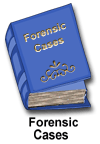|
|
 |
Unit.E.5.4.
Senior Abuse/ Neglect
 Australia
Australia |
focus
points
|
 |
Insert forensic focus points here
 Canada
Canada |
focus
points
|
 |
Elder abuse
and neglect are important social problems in Canada
and have been reviewed elsewhere (1,2). Since the reports
of "granny battering" by Baker and Burston
in 1975, research has become increasingly systematic
in attempting to clarify the nature, extent, and causes
of the problem (3,4). (Vida, Monks, & Des Rosiers,
2002).
Five broad types of abuse and neglect have been described:
physical abuse, psychological abuse or chronic verbal
aggression, material abuse or financial exploitation,
neglect (intentional or unintentional), and violation
of rights. Several references define these terms in
detail (1,2,5-10). (Vida, Monks, & Des Rosiers,
2002).
"Several community-based studies have estimated
the prevalence of elder abuse. In Canada, in a telephone
interview random sample of 2000 individuals over age
65 years living in private houses, Podnieks and others
reported a 4% prevalence of abuse or neglect, with 2.5%
financial abuse, 1.4% chronic verbal aggression, 0.5%
physical violence, and 0.4% neglect (9)."(Vida,
Monks, & Des Rosiers, 2002).
|
 International
International |
focus
points
|
 |
| "In
Denmark, Finland, and Sweden, Hydle reported a 1% to
8% prevalence of abuse by close relatives (14). In the
Netherlands, Comijs and others (15) reported a 1-year
abuse prevalence of 5.6% in a random sample of 1797
elderly persons living independently in Amsterdam, with
3.2% verbal aggression, 1.4% financial abuse, 1.2% physical
aggression, and 0.2% neglect (15). In Germany, Hirsch
and Brendebach (16) reported a 5-year abuse prevalence
of 10% in a postal questionnaire sample of elderly living
in Bonn, most often psychological and financial abuse"
(16). (Vida, Monks, & Des Rosiers, 2002). |
 United Kingdom
United Kingdom |
focus
points
|
 |
| Baker (1975)
first wrote about the concept of "granny-bashing"
in the British medical journals and described instances
where older citizens were abused by family members,
caregivers, health care employees, and a host of other
individuals. |
 United States
United States |
focus
points
|
 |
| The earliest
discussions of elder abuse
arose out of diverse fields: medicine (a "battered
old person syndrome" [Baker,1975]), family violence
research ("battered parents" [Steinmetz, 1978]),
and social work ("abuse of the elderly by informal
care providers" [Lau and Kosberg,1978) (Anetzberger,
2000).
In the
mid- 1970s the concept of "granny-bashing"
began to appear in British medical journals and described
instances where older citizens were abused by family
members, caregivers, health care employees, and a
host of other individuals (Baker, 1975; Ogg &
Munn-Giddings, 1993). At the same time, predictions
were made that the number of elderly citizens living
in the United States would increase gradually throughout
the 1980s and 1990s. Since then, two things have occurred.
First, we have seen increases in longevity and the
number of people ages 65 or older. Second, we have
witnessed the evolution of the granny-bashing concept
into other concepts viewed as more politically correct.
These new concepts included battered parent, elder
maltreatment, and elder abuse (Crystal, 1987; Katz,
1979; Pillemer, 1986). Although these new concepts
have been forthcoming, research into the way elder
abuse cases are handled in the legal system is relatively
scarce in the literature (Payne, Berg, & James,
2001).
Official estimates cited in the elder abuse literature
indicate that anywhere from 1 to 2 million adults
ages 65 or older are abused annually (Baron &
Welty, 1996; Wolf, 1996). Elderly victims often will
not report abuse because of a fear of retaliation,
shame, or beliefs that the system will do more harm
than good. Some fear they will be placed in a nursing
home if they report abuse, whereas others see reporting
as being nugatory, leading to a cumbersome process
placing on their lives time and economic constraints
that they would rather avoid (Payne, 2000). In fact,
some sources argue that only 1 in 14 cases of elder
abuse is reported (Bruce, 1994). Other sources suggest
that 1 in 10 older citizens are victims of abuse each
year (Heisler, 1991; Wolf, 1996, cited in Wolf, 2000).

With an increasing number of elders entering hospital
critical care units, the nurse in this setting has
a responsibility for detecting signs and symptoms
of elder abuse. Elder abuse is manifest in several
ways including inflicted physical harm as a result
of traumatic injuries or neglect, psychological threats
or intimidation, and even financial abuse when the
elder's resources have been misappropriated by the
caregiver (White, 2000).
There are about 34 million people in the United States
who are 65 years old (approximately 13% of the population),
and 4 million or 1.5 % are 85 years or older.I The
United States has an aging population. In 1900, the
average life expectancy was 47 years, but thanks to
improved diets, sanitation, and antibiotic medications,
the life expectancy now for women is 79 years and
72 years for men. The numbers for the oldestold, age
85 or greater, will increase tremendously over the
next 10-50 years as the Baby Boomer generation ages.2
By the year 2050, 19 million people or 24% of elders
in America will be in this oldest-old category.1 The
biggest growth of oldest-old was between 1960 and
1994 with an increase of 274%.2 With this large increase
in elderly, a new phenomenon was starting to be described
in 1975: "granny battering."' Elder abuse
may have been present long before this time, but recognition
of the issue did not have the public or the medical
community's attention. This article focuses on the
issues and concerns of elder abuse and the role of
the nurse in identification and management of the
problem (White, 2000).
The Amendments to the Older Americans Act, 1987, put
forth definitions on elder abuse, neglect, and exploitation.2
These definitions provided guidelines only and each
state developed its own interpretations and laws from
these definitions.4 There are four categories recognized
by the Older Americans Act as elder abuse: physical,
emotional, financial, and neglect. The National Center
on Elder Abuse (NCEA) believes that there should be
a total of seven areas, the above four plus self-neglect,
sexual abuse, and miscellaneous.3 Elder abuse could
be generally described as any intentional action or
nonaction that would cause harm to an elderly person.
The American Medical Association estimated that one
in four older persons have experienced some type of
abuse or neglect.6 Although these numbers seem high,
the actual number of reported cases can be low. Klienschmidt
3 performed an impromptu survey of emergency physicians
in the Dallas, Texas, area (White, 2000).
"Researchers have offered various theoretical
explanations of why elder abuse occurs: an overburdened
caregiver (situational model), a dependent elder or
perpetrator (exchange theory), a mentally/emotionally
disturbed perpetrator (psychopathology), and a childhood
of abuse and neglect (social learning theory). Others
have criticized the emphasis on individual traits.
They propose that structural forces such as the imbalance
of power within relationships (feminist theory) or
the marginalization of elders within society (political
economic theory) have created conditions that lead
to conflict and violence" (Wolf, 2000).

"In the US, Gioglio and Blakemore reported a
1% prevalence in a random sample of 342 community-dwelling
individuals over age 65 years, with financial abuse
being the most frequent form (over 50% of abuse) (11).
Pillemer and Finkelhor reported a 3.2% prevalence
in a telephone interview random sample of 2020 community-living
elderly, with 2% physical abuse, 1.1% verbal aggression,
and 0.4% neglect (8). Lachs and others linked an established
research cohort of 2812 community-dwelling older adults
in New Haven with protective service records (12)
and reported a 9-year prevalence of protective service
referral for elder abuse of 1.6% (13)." (Vida,
Monks, & Des Rosiers, 2002).
|
Focus Points
Reference
| Anetzberger,
G. J. (2000). Caregiving: Primary cause of |
elder
abuse? Generations, 24(2), 46-51.
Retrieved December 26, 2002, from Academic Search
Premier Database:
http://search.epnet.com/direct.asp?an=3539867&db=aph
|
| Heisler,
C. J. (2000). Elder Abuse and the Criminal |
Justice
System: New Awareness, New Responses. Generations,
24(2), 52-58. Retrieved December 26, 2002, from
Academic Search Premier Database: http://search.epnet.com/direct.asp?an=3539868&db=aph
|
| Payne, B.
K., Berg, B. L., & James, L. D. F. (2001). |
Attitudes
about sanctioning elder abuse offenders among police
chiefs, nursing home employees, and students. International
Journal of Offender Therapy and Comparative Criminology,
45(3), 363-382. Retrieved September 22, 2002
from the Proquest database.
|
| Vida, S.,
Monks, R. C., & Des Rosiers, P. (2002). |
Prevalence
and correlates of elder abuse and neglect in a geriatric
psychiatry service. Canadian Journal of Psychiatry,
47(5), 459- 467. Retrieved December 26, 2002,
from Academic Search Premier Database:
http://search.epnet.com/direct.asp?an=6854005&db=aph
|
| White, S.
(2000). Elder abuse: Critical care nurse role |
in detection.
Critical Care Nursing
Quarterly; 23(2), 20-25. Retrieved December
26, 2002, from Academic Search Premier Database:
http://search.epnet.com/direct.asp?an=6777999&db=aph
|
| Wolf, R.
S. (2000). The nature and scope of elder |
abuse.
Generations, 24(2), 6-12.
Retrieved December 26, 2002, from Academic Search
Premier Database:
http://search.epnet.com/direct.asp?an=3539244&db=aph
|
Top
of Page
|
 |
From
'forensic
presentations' in the forensic sourcebooks the following
presentations have been selected for this unit:
Unit.E.5.4.
Senior Abuse/ Neglect
Forensic
Medicine/Forensic History/Historical Firsts and Facts
 Australia
Australia |
Presentation(s)
|
 |
Insert power
point presentation here
 Canada
Canada |
Presentation(s)
|
 |
Elder Abuse
 International
International |
Presentation(s)
|
 |
Insert power
point presentation here
 United Kingdom
United Kingdom |
Presentation(s)
|
 |
Insert
power point presentation here
 United States
United States |
Presentation(s)
|
 |
Insert power
point presentation here
This
section will continually be added to with guest presentations
from forensic experts locally, nationally and internationally
and with student presentations.
Top
of Page
|
 |
 |
From
'forensic
cases' in the forensic sourcebooks the following case
studies have been selected for this unit
Unit.E.5.4.
Senior Abuse/ Neglect
Forensic
Medicine/Forensic History/Historical Firsts and Facts
 Australia
Australia |
case
study
|
 |
Insert case study
here
 Canada
Canada |
case
study
|
 |
Insert case study
here
 International
International |
case
study
|
 |
Insert case study
here
 United Kingdom
United Kingdom |
case
study
|
 |
Insert case study
here
 United States
United States |
case
study
|
 |
| Heisler,
C. J. (2000). Elder Abuse and the Criminal |
Justice
System: New Awareness, New Responses. Generations,
24(2), 52-58. Retrieved December 26, 2002, from
Academic Search Premier Database: http://search.epnet.com/direct.asp?an=3539868&db=aph
- Note:
The cases of elder abuse in the Heisler (2000) article
'' The
financial arena is a common area of abuse. In one
case, an elderly woman, the owner of several valuable
pieces of real estate, was befriended by a long-time
tenant who isolated her, convinced her that her "enemies"
intended to harm her, and took over her assets. He
invested in high-risk investment schemes, redecorated
the mansion he occupied, and bought a French chateau.
He employed his own friends to provide personal care
to the woman and drill her to pass a mental health
assessment indicating that she was competent to make
decisions about her financial affairs. He hired a
friend of his who was a certified accountant to give
her investment advice, and when he feared loss of
control over her assets, he married her'' (Heisler,
2000).
''In another case, a lonely, confused, and socially
isolated older man met a new acquaintance at a neighborhood
restaurant in San Francisco. In short order, she professed
great affection and love for him, and he quickly married
her He bought her a home in another community, which
the two never shared, added her as a joint tenant
to his bank accounts and other assets, and made a
will in her favor. The new wife was the mother of
children by her longterm common-law, or putative,
husband'' (Heisler, 2000).
''Sometimes offenders target neighborhoods where older
people live, working alone or in bands. They use a
variety of scams, representing themselves as home
repair contractors, utility department employees,
or workers from a governmental agency They gain the
older person's trust and quickly collect money for
services that are never performed or steal valuables
from the elder's home" (Sklar,1999, cited in
Heisler, 2000).
''Home healthcare workers have also exploited vulnerable
older people. For example, in one San Francisco case,
a nurse caring for a disabled older woman stole her
money and other valuables. The nurse was prosecuted
and placed on probation. She then befriended an elderly
man, married him, and began looting his assets. She
was prosecuted for another series of thefts and burglaries
from friends and associates. These new crimes and
the acts against her husband became the basis for
revoking her probation and sending her to prison ''
(Heisler, 2000).
''Examples of physical abuse and neglect are of course
the most sensational. In South Carolina, a 91-year-old
woman who was cared for by her children in their home
was neglected for so long that she developed a decubitus
ulcer that exposed her spine. Bobby pins used to hold
pads in place had become embedded in her skin. Bodily
waste was in the ulcer, and the smell was overwhelming.
She died of sepsis'' (Heisler, 2000).
''In southern California, two brothers allowed their
father to "rot" to death in bed until he
died from neglect, malnutrition, dehydration, and
septic shock from bedsores. The 68-year-old victim
was paralyzed, bedridden, and unable to control his
bodily functions. His sons lived in his rented home
and used his pension checks to pay the bills. One
son was responsible for managing the income; the other
was responsible for providing personal care. The father
was not fed, given water, taken to the bathroom, or
cleaned. The family knew that he needed medical care
but did not provide it (Wright, 1991, Heisler, 2000).
''In San Francisco, an 84-year-old woman with dementia
was admitted to a hospital with breathing difficulties
and covered with bruises, described by one expert
as similar to those sustained by airplane crash victims.
The attack was committed by her son'' (Heisler, 2000).
''Criminal justice professionals see domestic violence
cases involving elderly spouses. Some occur in long-term
marriages, with abuse having lasting over decades,
and others occur in new marriages. Some incidents
even occur after the battering spouse has died or
become incapacitated and the adult son steps into
his father's shoes and attacks his mother. In each
of these forms, the abuse is usually perpetrated to
accomplish power and control over the victim'' (Heisler,
2000).
|
Top
of Page
|
 |
From
'forensic
experts' in the forensic sourcebooks the following panel
of experts has been selected for this unit:
Unit.E.5.4.
Senior Abuse/ Neglect
|
|
forensic
panels of experts
|
 |
Insert forensic
panel here…………
 Australia
Australia |
authors/experts
|
 |
Insert specific
author/expert name(s) here
 Canada
Canada |
authors/experts
|
 |
Insert specific
author/expert name(s) here
 International
International |
authors/experts
|
 |
Insert specific
author/expert name(s) here
 United Kingdom
United Kingdom |
authors/experts
|
 |
Insert specific
author/expert name(s) here
 United States
United States |
authors/experts
|
 |
Insert specific
author/expert name(s) here
Top of Page
|
 |
| |
|